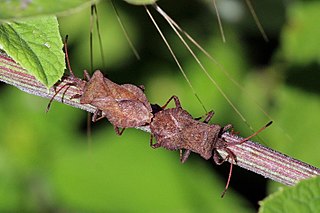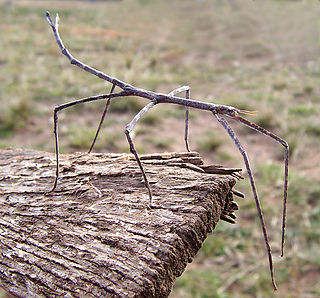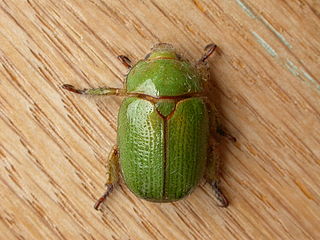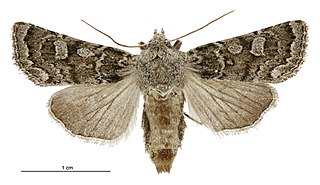
The Conopidae, also known as the thick-headed flies, are a family of flies within the Brachycera suborder of Diptera, and the sole member of the superfamily Conopoidea. Flies of the family Conopidae are distributed worldwide in all the biogeographic realms except for the poles and many of the Pacific islands. About 800 species in 47 genera are described worldwide, about 70 of which are found in North America. The majority of conopids are black and yellow, or black and white, and often strikingly resemble wasps, bees, or flies of the family Syrphidae, themselves notable bee mimics. A conopid is most frequently found at flowers, feeding on nectar with its proboscis, which is often long.

The eastern whipbird is an insectivorous passerine bird native to the east coast of Australia. Its whip-crack song is a familiar sound in forests of eastern Australia. Two subspecies are recognised. Heard much more often than seen, it is dark olive-green and black in colour with a distinctive white cheek patch and a crest. The male and female are similar in plumage.

The Agromyzidae are a family of flies, commonly referred to as the leaf-miner flies for the feeding habits of their larvae, most of which are leaf miners on various plants. It includes roughly 2,500 species, they are small, some with wing length of 1 mm. The maximum size is 6.5 mm. Most species are in the range of 2 to 3 mm.

Dolichopodidae, the long-legged flies, are a large, cosmopolitan family of true flies with more than 8,000 described species in about 250 genera. The genus Dolichopus is the most speciose, with some 600 species.

Eurybrachidae is a small family of planthoppers with species occurring in parts of Asia, Australia and Africa. They are remarkable for the sophistication of their automimicry.

Alisterus is a genus of medium-sized Australasian parrots, comprising the Australian king parrot, the Papuan king parrot and the Moluccan king parrot. The three species are respectively found in eastern Australia, Papua, the Moluccas and other Indonesian islands. Predominantly of red and green plumage, the long-tailed parrots are related to the genera Aprosmictus and Polytelis.

Coreus marginatus is a herbivorous species of true bug in the family Coreidae. It is commonly known as the dock bug as it feeds on the leaves and seeds of docks and sorrels. It is a medium-sized speckled brown insect, between 13 and 15 mm long as an adult, with a broad abdomen. It occurs throughout Europe, Asia and northern Africa. It is often found in dense vegetation, such as hedgerows and wasteland.

Ichneutica semivittata is a moth of the family Noctuidae. It is endemic to New Zealand. It can be found from the Three King Islands down to Stewart Island. The similar species I. sulcana can be distinguished from I. semivittata as the former is much larger, has a darker hindwing and abdomen and has only one to three spots located behind the middle of the forewing in comparison to the 8 or 9 of I. semivittata. This species lives in a variety of habitats from open grasslands to clearings in forest and at a range of altitudes from the sea level to the alpine zone. Larval host species include Juncus procera, Carex secta as well as on tussock grasses such as Poa cita, P. colensoi and Festuca novae-zelandiae. Adults of this species are on the wing from August to April and are attracted to light.

Ctenomorpha marginipennis, the margin-winged stick insect, is a species of stick insect endemic to southern Australia. The species was first described by George Robert Gray in 1833.

Gastrophysa viridula, known as the green dock beetle, green dock leaf beetle or green sorrel beetle, is a species of beetle native to Europe.

Conopomorpha flueggella is a moth of the family Gracillariidae. It is known from Tianjin, China.

Ichneutica plena is a moth of the family Noctuidae. It is endemic to New Zealand. It is widespread throughout the North, South and Stewart Islands. It is a variable in appearance and therefore can be confused with its near relatives I. peridotea and I. insignis. The larvae of I. plena feed on herbaceous plants including Fuchsia excorticata, Coprosma species, and introduced species such as garden fuchsia as well as crops such as apple trees. Adults of this species are on the wing from late August until May.

Ichneutica oliveri is a moth of the family Noctuidae. It is endemic to New Zealand, found only in the South Island. However it has not been observed on the eastern side of that island from mid-Canterbury southwards to Southland. This species is distinctive and is unlikely to be confused with other closely related species. It inhabits tussock grasslands, shrubland as well as granite sand plains, all in the alpine zone. Adults are on the wing from December to March and are attracted to light. They have been observed feeding on the flowers of Hebe species. The life history of this species is unknown as are the larval hosts.

Anoplognathus prasinus, commonly known as the green Christmas beetle, is a beetle of the family Scarabaeidae native to eastern Australia.

Pseudicius sengwaensis is a species of jumping spider in the genus Pseudicius that lives in Zimbabwe. It is found in the Sengwa Wildlife Research Area, after which it is named. The spider was first described in 2011 by Wanda Wesołowska and Meg Cumming. The female has not been identified. The species is very similar to Afraflacilla venustula, including the pattern on the abdomen. It is a small spider, with a cephalothorax that is typically 1.8 mm (0.071 in) long and an abdomen typically 2.3 mm (0.091 in) long. It can be most easily distinguished from other members of the genus by its copulatory organs. The palpal bulb has a distinctive irregular shape, as is the embolus base.

Chalcoscirtus picinus is a species of jumping spider in the genus Chalcoscirtus that has been only found in the United Arab Emirates. The spider was first described in 2011 by Wanda Wesołowska and Antonius van Harten. It is a small spider, with a cephalothorax typically 1.4 mm (0.06 in) long and an abdomen typically 2 mm (0.08 in) long. It is hard to tell externally from other spiders as it is similar in size to others in the genus and, like many others, lacks a distinctive pattern on its body. Its carapace is generally greyish-brown with a black eye field while its abdomen is blackish-grey. The spider's copulatory organs. are its most distinguishing feature. The female has a small window made of membrane in the middle of its epigyne, which is narrower than that found in other species in the genus. The male has not been described.

Chrysogaster antitheus , the Short-haired Wrinkle Fly, is a fairly common species of syrphid fly found in North America. Hoverflies get their names from the ability to remain nearly motionless while in flight. The adults are also known as flower flies for they are commonly found around and on flowers, from which they get both energy-giving nectar and protein-rich pollen. The larvae in this genus are aquatic rat-tailed larvae.

Ichneutica sistens is a moth of the family Noctuidae. This species is endemic to New Zealand. It can be found in the central North Island and throughout the South Island, although it is more common on the eastern side of that latter Island. It is very variable in both colour and size. I. sistens prefers open habitat such as tussock grasslands, dunes and braided rivers. Larval host species include grasses in the family Poaceae and include species in the genera Rytidosperma and Elymus, as well as Poa cita and Agrostis capillaris. Adults are on the wing from January to May and are attracted to light.

Brachyopa cynops , the Matt-tailed Sapeater, is a rare species of syrphid fly. It has been collected in Colorado. Hoverflies get their names from the ability to remain nearly motionless while in flight. The adults are also known as flower flies for they are commonly found around and on flowers, from which they get both energy-giving nectar and protein-rich pollen. Larvae for this genus are of the rat-tailed type. B.cynops larvae have not been described.
Orthonevra robusta, the short-horned mucksucker, is a rare species of syrphid fly, located in the Western United States. It was described by Raymond Corbett Shannon in 1916. Hoverflies are able to be motionless while in flight.They are also called flower flies, for they are commonly found around and on flowers from which they get both energy-giving nectar and protein rich pollen. Larvae for this genus are of the rat-tailed type. O. robusta larvae have not been described.



















